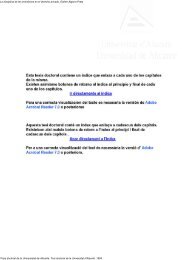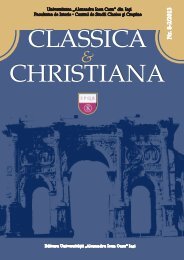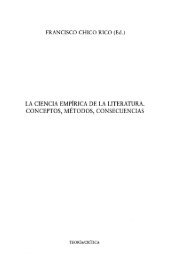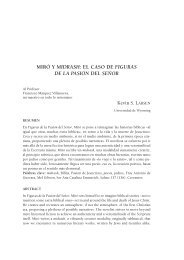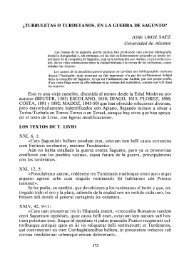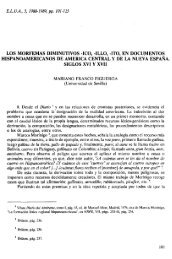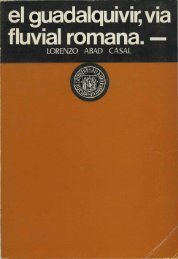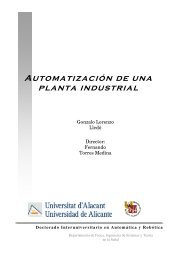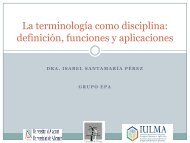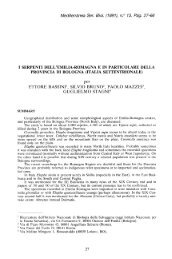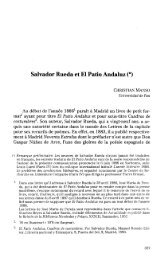goethean rhymes and rhythms in verse translations of faust ... - RUA
goethean rhymes and rhythms in verse translations of faust ... - RUA
goethean rhymes and rhythms in verse translations of faust ... - RUA
Create successful ePaper yourself
Turn your PDF publications into a flip-book with our unique Google optimized e-Paper software.
GOETHEAN RHYMES AND RHYTHMS IN VERSE<br />
TRANSLATIONS OF FAUST INTO SPANISH 1 Stefan Beyer<br />
st_beyer@arcor.de<br />
Universidad Nacional Autónoma de México<br />
Abstract<br />
The few translators who have attempted a Spanish <strong>verse</strong> translation <strong>of</strong> Goethe's Faust for the<br />
most part fail to do justice to the metrical diversity <strong>of</strong> Goethe's play <strong>and</strong> therefore either<br />
altogether give up the idea <strong>of</strong> render<strong>in</strong>g Goethe's play <strong>in</strong> poetry, e.g. Pedro Gálvez <strong>in</strong> 1984, or<br />
they create a traditionalist Spanish Faust poem with excessive liberties regard<strong>in</strong>g its content,<br />
e.g., <strong>in</strong> 1882, Teodoro Llorente. Others have tried to fit Goethe’s <strong>verse</strong> <strong>in</strong> the Procrustean bed <strong>of</strong><br />
unrhymed endecasílabos, which has forced them to abridge the orig<strong>in</strong>al text <strong>in</strong> numerous<br />
passages (Valverde 1962). Moreover, some translators, such as Valverde <strong>and</strong> Silvetti Paz (1970),<br />
translate some passages <strong>of</strong> Goethe's magnum opus <strong>in</strong>to Spanish <strong>verse</strong>s resembl<strong>in</strong>g unrhymed<br />
iambic pentameter, a rather unusual approach <strong>in</strong> Spanish poetry, but nevertheless surpris<strong>in</strong>gly<br />
effective. The translation which clearly st<strong>and</strong>s out is the one by Augusto Bunge (1926, 1949),<br />
who carefully studied <strong>and</strong> analyzed the metrical structure <strong>of</strong> Faust <strong>and</strong> created a Spanish version<br />
which imitates Goethe’s complex <strong>rhythms</strong> <strong>and</strong> rhyme patterns while rema<strong>in</strong><strong>in</strong>g largely faithful<br />
to the German orig<strong>in</strong>al.<br />
Abstract<br />
Die H<strong>and</strong>voll Autoren spanischsprachiger Versübersetzungen von Goethes Faust scheitert<br />
mehrheitlich daran, dass die Übersetzer der metrischen Vielfalt des Ausgangstexts nicht gerecht<br />
werden und deswegen entweder die Idee e<strong>in</strong>er poetischen Wiedergabe ganz aufgeben (so etwa<br />
Gálvez 1984) oder e<strong>in</strong> spanisch-traditionalistisches Faust-Gedicht schaffen und sich dabei<br />
<strong>in</strong>haltlich die allergrößten Freiheiten erlauben, zum Beispiel Teodoro Llorente 1882. Andere<br />
Übersetzer, allen voran José María Valverde (1963), versuchen die komplexe Metrik Goethes <strong>in</strong><br />
das Prokrustesbett des ungereimten endecasílabo zu pressen, was regelmäßig zu <strong>in</strong>haltlichen<br />
Auslassungen führt. Autoren wie Valverde und Silvetti Paz (1970) erzielen für spanische Lyrik<br />
ungewöhnliche, aber überraschend wirkungsvolle Effekte, <strong>in</strong>dem sie endecasílabos verwenden,<br />
die rhythmisch dem Blankvers verw<strong>and</strong>t s<strong>in</strong>d. Die Faust-Übersetzung Augusto Bunges (1926,<br />
1949) besticht dadurch, dass sie auf e<strong>in</strong>er genauen Analyse der Metrik des Orig<strong>in</strong>als fußt und<br />
sich deshalb Goethes komplexen rhythmischen Strukturen und Reimen annähert, wobei sie dem<br />
Orig<strong>in</strong>al <strong>in</strong>haltlich an vielen Stellen treu bleibt.<br />
Key words: Goethe. Faust. Metrical versions <strong>in</strong> Spanish. Translation.<br />
Stichwörter: Goethe. Faust. Versübersetzungen Spanisch. Übersetzung.<br />
1 This article is the English version <strong>of</strong> “Los ritmos y la rima de la versificación <strong>goethean</strong>a en las versiones métricas<br />
del Fausto en español” by Stefan Beyer. It was not published on the pr<strong>in</strong>t version <strong>of</strong> MonTI for reasons <strong>of</strong> space. The<br />
onl<strong>in</strong>e version <strong>of</strong> MonTI does not suffer from these limitations, <strong>and</strong> this is our way <strong>of</strong> promot<strong>in</strong>g pluril<strong>in</strong>gualism.<br />
MonTI 5trans (2013). ISSN 1889-4178. http://dx.doi.org/10.6035/MonTI.2013.5.15
2trans<br />
Beyer, Stefan<br />
Accord<strong>in</strong>g to the Catalan physician <strong>and</strong> theosopher José Roviralta Borrell (1920:7), whose prose<br />
translation is reputed to be the most faithful one to this day, translat<strong>in</strong>g Goethe's Faust is a task<br />
“worthy <strong>of</strong> titans”. For future translators, especially those attempt<strong>in</strong>g to create a Spanish Faust<br />
<strong>in</strong> <strong>verse</strong>, it is therefore helpful to study the exist<strong>in</strong>g versions, as they provide a guidel<strong>in</strong>e as to<br />
which approaches may be adopted <strong>and</strong> which are best avoided. This study is part <strong>of</strong> my attempts<br />
to help prepare new <strong>and</strong> improved <strong>verse</strong> <strong>translations</strong> <strong>of</strong> Goethe's Faust <strong>in</strong>to Spanish.<br />
Over the past one hundred <strong>and</strong> fifty years, a large number <strong>of</strong> <strong>translations</strong> <strong>in</strong>to Spanish <strong>of</strong><br />
Goethe's magnum opus have been published. Initially, they <strong>of</strong>ten reflected certa<strong>in</strong> cultural<br />
misunderst<strong>and</strong><strong>in</strong>gs <strong>and</strong> stereotypes, for example, the Faust character <strong>in</strong> those early versions <strong>in</strong><br />
Spanish <strong>of</strong>ten appears to be an unscrupulous seducer, whose sole aim it is to obta<strong>in</strong> love <strong>and</strong><br />
knowledge by means <strong>of</strong> magic. The author <strong>of</strong> this seem<strong>in</strong>g German Don Juan, “the most<br />
questionable” <strong>of</strong> our classics accord<strong>in</strong>g to José Ortega y Gasset (1932: 46), appeared to be<br />
equally <strong>in</strong>human until well <strong>in</strong>to the 20 th century. Even a learned homme de lettres like Rafael<br />
Cans<strong>in</strong>os Assens (1957: 1: 252) arrives at the disturb<strong>in</strong>g conclusion about Goethe that<br />
he sacrificed everyth<strong>in</strong>g for his proper ego: loves, friends, everyth<strong>in</strong>g. He was a good adm<strong>in</strong>istrator<br />
both <strong>of</strong> his wealth <strong>and</strong> his adrenal<strong>in</strong>e. His triumphant path is scattered with bloodless victims. His<br />
law is the law <strong>of</strong> the strongest; those who cannot resist him have to die.<br />
The cultural misunderst<strong>and</strong><strong>in</strong>gs <strong>in</strong>volved <strong>in</strong> the reception Goethe met with <strong>in</strong> Spa<strong>in</strong> <strong>in</strong> the 19th<br />
<strong>and</strong> early 20 th centuries were thoroughly studied by Udo Rukser (1958) <strong>and</strong> Robert Pageard<br />
(1958).<br />
The history <strong>of</strong> the <strong>verse</strong> <strong>translations</strong> <strong>in</strong>to Spanish <strong>of</strong> Goethe's Faust is even more surpris<strong>in</strong>g,<br />
due to the fact that the secrets <strong>of</strong> Goethe's versification are not easily revealed. In general, the<br />
pr<strong>in</strong>ciples <strong>of</strong> <strong>verse</strong> composition <strong>in</strong> Spanish <strong>and</strong> German go by different st<strong>and</strong>ards. In Hispanic<br />
meters, the ma<strong>in</strong> criterion is the number <strong>of</strong> syllables per <strong>verse</strong>, whereas the distribution <strong>of</strong><br />
stressed syllables can be used to vary the rhythm <strong>of</strong> this ever same number <strong>of</strong> syllables, e.g. an<br />
endecasílabo can have a trochaic or a dactylic rhythm, but they are not always expected to form<br />
regular patterns. In the century <strong>in</strong> which Goethe was born, German metrics had come to focus<br />
less on the overall number <strong>of</strong> syllables per <strong>verse</strong> <strong>and</strong> more on the number <strong>of</strong> stressed syllables,<br />
thus imitat<strong>in</strong>g the rules <strong>of</strong> versification common <strong>in</strong> antiquity. Consequently, the rules for writ<strong>in</strong>g<br />
pentameters are not quite the same as for endecasílabos.<br />
Among the twenty-six meters employed <strong>in</strong> the first part <strong>of</strong> Faust, the most characteristic one<br />
is the Knittelvers, a type <strong>of</strong> pentameter rhymed <strong>in</strong> couplets with certa<strong>in</strong> irregularities, which<br />
became famous through the carnival plays <strong>of</strong> Hans Sachs <strong>in</strong> the 16 th century. Two centuries later,<br />
Goethe employed the then ill-reputed Knittel <strong>verse</strong> <strong>in</strong> a provocative manner creat<strong>in</strong>g a<br />
somewhat comic, doggerel-type effect (cf. Ciupke 1994: 38). However, more than half the 4612<br />
<strong>verse</strong>s <strong>of</strong> Faust I are written <strong>in</strong> Madrigalvers, a meter rhymed either <strong>in</strong> couplets, alternately or<br />
enclos<strong>in</strong>g, <strong>in</strong> which <strong>verse</strong>s <strong>of</strong> four, five or six iambic feet are alternated. Goethe also used the<br />
Stanzenstrophe (ottava rima) for his Faust, a stanza consist<strong>in</strong>g <strong>of</strong> eight iambic pentameters<br />
rhym<strong>in</strong>g abababcc. The <strong>rhythms</strong> <strong>of</strong> Goethe's poem are so varied that not even the most<br />
elaborate prose could do them justice, e.g. the melodic chant <strong>of</strong> the archangels or the dreamy<br />
stammer <strong>of</strong> the protagonist when he expla<strong>in</strong>s his creed to his <strong>in</strong>genuous lover Margaret.<br />
The other crucial aspect <strong>of</strong> the unmistakable metrical form <strong>of</strong> Faust are its <strong>rhymes</strong>. How are<br />
translators to approach passages <strong>in</strong> which rhyme is turned <strong>in</strong>to the topic <strong>of</strong> conversation <strong>of</strong><br />
rhymed dialogue, e.g. when it is claimed <strong>in</strong> “Walpurgis Night's Dream” that the German noun<br />
MonTI 5trans (2013). ISSN 1889-4178
Goethean Rhymes <strong>and</strong> Rhythms <strong>in</strong> Verse Translations <strong>of</strong> Faust <strong>in</strong>to Spanish<br />
3trans<br />
Teufel only <strong>rhymes</strong> with Zweifel (a rhyme actually used by the protagonist <strong>in</strong> his <strong>in</strong>itial<br />
soliloquy) or the poetic encounter between Faust <strong>and</strong> Helen, <strong>in</strong> the course <strong>of</strong> which rhyme is<br />
turned <strong>in</strong>to a melodic metaphor <strong>of</strong> love, thus embody<strong>in</strong>g the convergence <strong>of</strong> antiquity <strong>and</strong> the<br />
modern age (vv. 9367f.)? Goethe's irreverent mastery <strong>of</strong> rhyme expressed <strong>in</strong> such passages<br />
creates such a clarity <strong>and</strong> thought-provok<strong>in</strong>gness <strong>of</strong> expression that many l<strong>in</strong>es from this play <strong>of</strong><br />
epic dimensions have become proverbial <strong>in</strong> German. Nevertheless, for the translators, the<br />
<strong>rhymes</strong> can become an <strong>in</strong>surmountable obstacle. Thus we notice that they are forced to <strong>in</strong>vert<br />
the natural sentence structure far more <strong>of</strong>ten than Goethe. Be that as it may, <strong>in</strong> the case <strong>of</strong><br />
Goethe's Faust, the comm<strong>and</strong>ment <strong>of</strong> fidelity should not be understood solely with respect to<br />
the content <strong>of</strong> the text, but also concern<strong>in</strong>g its versification.<br />
No doubt a prose Faust would evoke ideas altogether different from the orig<strong>in</strong>al, s<strong>in</strong>ce<br />
Goethe's <strong>verse</strong>s contribute vitally to the effect the text has had on readers <strong>and</strong> audiences. In the<br />
second half <strong>of</strong> the 20 th century, the exceed<strong>in</strong>gly complex metrical composition <strong>of</strong> Faust was<br />
studied by Trunz (1949) <strong>and</strong>, more <strong>in</strong> detail, by Ciupke (1994). They show to what extend<br />
Goethe's <strong>rhythms</strong> <strong>and</strong> <strong>rhymes</strong> give life to his characters <strong>and</strong> their emotions. For example, the<br />
frequent metrical changes <strong>in</strong> Faust's <strong>verse</strong>s give us an idea <strong>of</strong> how this character's m<strong>in</strong>d <strong>and</strong><br />
mood fluctuate. What is more, accord<strong>in</strong>g to Ciupke (1994: 20), the use <strong>of</strong> a great variety <strong>of</strong><br />
irregular meters symbolizes the radical <strong>in</strong>dividualism <strong>of</strong> Goethe's protagonist:<br />
He alone among all the characters has mastered all the <strong>verse</strong> forms [...]. However, above all, his<br />
discourse is characterized by free <strong>rhythms</strong> <strong>and</strong> free <strong>verse</strong>, the meters <strong>of</strong> the immediate expression<br />
<strong>of</strong> the <strong>in</strong>dividual.<br />
Likewise, the Madrigalvers employed by the w<strong>in</strong>some devil Mephistopheles illustrates the<br />
seductive elegance <strong>of</strong> that character. Mephistopheles tends to imitate the meters used by other<br />
characters <strong>and</strong> adapt to their diction, which is yet another strategy to manipulate everyone (cf.<br />
Ciupke 1994: 20).<br />
On May 5, 1798, <strong>in</strong> a letter to his colleague Friedrich Schiller, councillor Goethe<br />
enthusiastically wrote that the newly achieved metrical version <strong>of</strong> certa<strong>in</strong> scenes <strong>in</strong> the f<strong>in</strong>al<br />
manuscript <strong>of</strong> Faust I dampened the enormous ideas <strong>of</strong> the play like a “gauze”. The muchadmired<br />
poet from Weimar had dictated the first scenes <strong>of</strong> his play when he was only twentytwo<br />
or twenty-three. He was look<strong>in</strong>g for more immediate <strong>and</strong> more authentic forms <strong>of</strong> literary<br />
expression than those used by many <strong>of</strong> his contemporaries, which led him to the popular genres<br />
<strong>and</strong> themes <strong>of</strong> 16 th century Germany. In the second stage <strong>of</strong> the creation <strong>of</strong> Faust, dur<strong>in</strong>g the last<br />
decade <strong>of</strong> the 18 th century, i.e. <strong>in</strong> his neoclassicist phase, Goethe versified almost all the<br />
rema<strong>in</strong><strong>in</strong>g prose scenes <strong>of</strong> his orig<strong>in</strong>al Sturm und Drang manuscript, because they seemed<br />
“unbearable” to him, as he confided to Schiller <strong>in</strong> the same letter.<br />
The first author <strong>of</strong> a <strong>verse</strong> translation <strong>of</strong> Goethe's play <strong>in</strong>to Spanish, the Valencian poet<br />
Teodoro Llorente (1882: 31), dreamed <strong>of</strong> “grant<strong>in</strong>g citizenship to the great creation <strong>of</strong> Goethe <strong>in</strong><br />
our native literature [...]: we have to adapt its expressions to the peculiar nature <strong>of</strong> our poetics,<br />
we have to give it a truly Castilian tang.” Llorente probably did not underst<strong>and</strong> German very<br />
well <strong>and</strong> was not at all <strong>in</strong>terested <strong>in</strong> literary criticism on Faust (cf. Beyer 2012: 35-38).<br />
Throughout the 20 th century, <strong>in</strong> reviews <strong>of</strong> Llorente's Fausto, a certa<strong>in</strong> mockery <strong>of</strong> his “solemn,<br />
archaic <strong>and</strong> somewhat declamatory style” (Pageard 1958: 150) can be felt, which I, however,<br />
th<strong>in</strong>k unjustified. Nonetheless, despite the poetic artistry <strong>of</strong> many passages, it would be more<br />
appropriate to call Llorente's version not a translation, but a work <strong>in</strong>spired by Goethe.<br />
One reason is that Llorente employs predom<strong>in</strong>antly octosílabos <strong>and</strong> perfect rhyme, which<br />
causes his version to deviate from the source text concern<strong>in</strong>g its form <strong>and</strong> content. For <strong>in</strong>stance,<br />
on Easter Sunday, Faust <strong>and</strong> his aide Wagner take a walk admir<strong>in</strong>g the first signs <strong>of</strong> spr<strong>in</strong>g. In<br />
his large description, Faust also mentions the river scattered with “merry d<strong>in</strong>ghies” (Faust, vv.<br />
931-932):<br />
Wie der Fluß, <strong>in</strong> Breit' und Länge,<br />
So manchen lustigen Nachen bewegt [...]<br />
MonTI 5trans (2013). ISSN 1889-4178
4trans<br />
Beyer, Stefan<br />
The meters employed by Faust <strong>in</strong> German reflect the approach<strong>in</strong>g spr<strong>in</strong>g <strong>and</strong> the cheerfulness <strong>of</strong><br />
the placid country folk. They are not unlike the Knittel<strong>verse</strong> with which he <strong>in</strong>troduces himself to<br />
the audience at the beg<strong>in</strong>n<strong>in</strong>g <strong>of</strong> the “tragedy,” only they are not rhymed <strong>in</strong> couplets <strong>and</strong> they<br />
lack the irregularities which h<strong>in</strong>t at the exasperation <strong>of</strong> the protagonist <strong>in</strong> that first “Night” scene<br />
(cf. Ciupke 1994: 49). Llorente's (1882: 90) attempt at render<strong>in</strong>g this scene <strong>in</strong> octosílabos fails,<br />
because this unnecessarily severe formal constra<strong>in</strong>t compels him to omit important expressions.<br />
Moreover, the rhythm is altered considerably; <strong>in</strong> Llorente's version it is much more<br />
cumbersome:<br />
¡Cuántos lleva el ancho río<br />
esquifes empavesados!<br />
There is another example, which illustrates to what extend Llorente's version becomes<br />
unreliable due to his choice <strong>of</strong> meters <strong>and</strong> his frequent use <strong>of</strong> perfect rhyme. In one <strong>of</strong> the f<strong>in</strong>al<br />
scenes <strong>of</strong> the first part <strong>of</strong> the play, Faust, with the help <strong>of</strong> Mephistopheles's magic tricks,<br />
wounds Margaret's soldierly brother Valent<strong>in</strong>e <strong>in</strong> a duel. After Faust <strong>and</strong> Mephistopheles have<br />
fled, Valent<strong>in</strong>e, dy<strong>in</strong>g, reviles his sister call<strong>in</strong>g her a “whore”. Aghast, Margaret cries “God!”,<br />
whereupon he admonishes her, urg<strong>in</strong>g her to keep God out <strong>of</strong> the matter (Faust, v. 3733):<br />
Lass' unsern Herr Gott aus dem Spaß.<br />
Valent<strong>in</strong>e literally tells his sister to keep God out <strong>of</strong> the “joke,” but what he means <strong>in</strong> fact, <strong>in</strong> an<br />
ironic way, is the 'issue' <strong>of</strong> his lost life <strong>and</strong> her lost virg<strong>in</strong>ity, which becomes obvious <strong>in</strong> the<br />
article “spasz” <strong>of</strong> Jakob <strong>and</strong> Wilhelm Grimm's dictionary, where said <strong>verse</strong> 3733 from Faust is<br />
quoted as an example <strong>and</strong> expla<strong>in</strong>ed <strong>in</strong> the follow<strong>in</strong>g manner: im weitesten s<strong>in</strong>ne wie sache,<br />
angelegenheit überhaupt, scherzhaft oder ironisch (“<strong>in</strong> the broadest sense mean<strong>in</strong>g matter, issue<br />
at h<strong>and</strong>, jok<strong>in</strong>gly or ironically”). Furthermore, the preced<strong>in</strong>g <strong>verse</strong> 3732 <strong>of</strong> Faust, spoken by<br />
Margaret, ends <strong>in</strong> the pronoun das; therefore it is likely that Goethe used the unusual noun Spaß<br />
because the two words rhyme. Surpris<strong>in</strong>gly, the Spanish version by Teodoro Llorente (1882:<br />
292) is neither literal nor did he make use <strong>of</strong> a paraphrase, but he arbitrarily <strong>in</strong>troduced the<br />
idiom tener ni arte ni parte ('have noth<strong>in</strong>g whatsoever to do with'):<br />
Dios no tiene arte ni parte<br />
en esto: déjale aparte […]<br />
The Argent<strong>in</strong>e physician <strong>and</strong> social reformer Augusto Bunge (1926: 11) claims he learned from<br />
Llorente what is best avoided <strong>in</strong> a <strong>verse</strong> translation <strong>of</strong> Goethe's Faust, “concern<strong>in</strong>g both its<br />
metrical structures <strong>and</strong> its diction.” Bunge's Faust was published <strong>in</strong> 1926 <strong>in</strong> Buenos Aires,<br />
apparently follow<strong>in</strong>g one year <strong>of</strong> arduous work. In 1949, another edition came out<br />
posthumously, edited by Juan C. Probst, which conta<strong>in</strong>s various revisions made by the late<br />
Bunge, without any doubt evidence that the translator had kept improv<strong>in</strong>g his version dur<strong>in</strong>g the<br />
decades after the first publication. Bunge's approach to metrics is radically opposed to the one<br />
<strong>of</strong> Llorente. In fact, he is the first translator <strong>of</strong> Faust who worried at an adequate metrical form.<br />
Bunge's (1926: 13) aim was to recreate <strong>in</strong> Spanish what he called the “modernist” forms<br />
employed by Goethe, i.e. the irreverent use the Weimar poet had made <strong>of</strong> the traditional forms<br />
laid down by the manuals <strong>of</strong> his day. At the same time, Bunge wanted to achieve a faithful<br />
translation, which for him implied “break<strong>in</strong>g with our stereotypical metrical formulas”. Bunge<br />
was aga<strong>in</strong>st “uniform” <strong>verse</strong>s, which seemed like a “Procrustean bed” to him, <strong>and</strong> preferred<br />
irregular meters – just like Goethe. Furthermore, he tried to reproduce “the style <strong>and</strong> tone<br />
correspond<strong>in</strong>g to every character <strong>and</strong> every situation” (Bunge 1926: 13).<br />
Dur<strong>in</strong>g the above-mentioned walk on Easter Sunday, Wagner, Faust's assistant, admits that<br />
he too has had hours <strong>of</strong> melancholy, but he does not underst<strong>and</strong> Faust's impulse towards the<br />
heavens. (Faust, vv. 1100-1101):<br />
Ich hatte selbst <strong>of</strong>t grillenhafte Stunden,<br />
MonTI 5trans (2013). ISSN 1889-4178
Goethean Rhymes <strong>and</strong> Rhythms <strong>in</strong> Verse Translations <strong>of</strong> Faust <strong>in</strong>to Spanish<br />
5trans<br />
Doch solchen Trieb hab' ich noch nie empfunden.<br />
Wagner speaks <strong>in</strong> Madrigal<strong>verse</strong> with a markedly regular rhythm, to the po<strong>in</strong>t <strong>of</strong> sound<strong>in</strong>g<br />
tedious. In Bunge's (1926: 70) version, a similar effect is created merely through rhym<strong>in</strong>g<br />
couplets:<br />
También yo tuve algún momento extravagante,<br />
Mas nunca sentí impulso semejante.<br />
Augusto Bunge recreates the great variety <strong>of</strong> the <strong>rhymes</strong> <strong>and</strong> <strong>rhythms</strong> <strong>of</strong> Goethe's Madrigalvers<br />
through a skilful array <strong>of</strong> metrical forms, which becomes obvious <strong>in</strong> the second scene at Faust's<br />
study, where Mephistopheles appears for the first time, dressed up as a travell<strong>in</strong>g student.<br />
Goethe employs <strong>verse</strong>s <strong>of</strong> five <strong>and</strong> six iambic feet (Faust, vv. 1349-1352):<br />
Ich b<strong>in</strong> e<strong>in</strong> Teil des Teils, der Anfangs alles war,<br />
E<strong>in</strong> Teil der F<strong>in</strong>sternis, die sich das Licht gebar,<br />
Das stolze Licht, das nun der Mutter Nacht<br />
Den alten Rang, den Raum ihr streitig macht [...]<br />
Bunge (1926: 81) makes use <strong>of</strong> alex<strong>and</strong>r<strong>in</strong>es, heptasílabos <strong>and</strong> endecasílabos with varied rhyme<br />
schemes <strong>and</strong> <strong>in</strong> part he imitates the iambic rhythm <strong>of</strong> the Madrigalvers.<br />
Soy parte de la parte que al pr<strong>in</strong>cipio fue todo,<br />
Parte de las t<strong>in</strong>ieblas que a la luz dieron vida;<br />
La luz dom<strong>in</strong>adora,<br />
La que a la Madre Noche, s<strong>in</strong> respeto,<br />
El rango y sitio le disputa ahora.<br />
Bunge's subtlety <strong>in</strong> imitat<strong>in</strong>g Goethe's <strong>rhythms</strong> can be seen <strong>in</strong> a somewhat obscure passage later<br />
on <strong>in</strong> the same scene, after the hero has fallen asleep (Faust, vv. 1457-1460). Accord<strong>in</strong>g to Hans<br />
Arens (1982: 165), the chant <strong>of</strong> the spirits <strong>in</strong> those l<strong>in</strong>es describes cloud formations:<br />
Himmlischer Söhne<br />
Geistige Schöne,<br />
Schwankende Beugung<br />
Schwebet vorüber.<br />
The dactylic rhythm <strong>of</strong> these <strong>verse</strong>s is recreated very neatly by Augusto Bunge (1926: 85), if <strong>in</strong><br />
two long l<strong>in</strong>es <strong>in</strong>stead <strong>of</strong> the four short ones <strong>of</strong> the source text:<br />
De hijos celestes ideal belleza<br />
Grácil se <strong>in</strong>cl<strong>in</strong>a; leve se esfuma [...]<br />
The moment when Faust stammers out his pantheistic creed to his <strong>in</strong>genuous lover is one <strong>of</strong> the<br />
most irregular passages metrically speak<strong>in</strong>g. Even the rhyme, which Goethe thought so<br />
important for s<strong>of</strong>ten<strong>in</strong>g the effect <strong>of</strong> his play, has disappeared <strong>in</strong> this vital scene. Very much like<br />
his convictions, which diverge from the dogmas <strong>of</strong> the ma<strong>in</strong> churches, Faust also uses a rather<br />
<strong>in</strong>dividualistic language: he expresses himself <strong>in</strong> short, irregular <strong>verse</strong>s, <strong>in</strong> a “hymnic” tone<br />
(Ciupke 1994: 77). Not only does Bunge (1926: 191) imitate these irregular <strong>rhythms</strong> by means<br />
<strong>of</strong> the silva, he also ab<strong>and</strong>ons his frequent use <strong>of</strong> perfect rhyme <strong>and</strong> employs imperfect rhyme:<br />
¡No me comprendas mal, mi niña bella!<br />
¿Quién puede osar nombrarle? ¿Quién osara<br />
Decir: yo creo en él? ¿Y quién pudiera<br />
Sentir y osar decirlo: en él no creo?<br />
El que todo lo alienta,<br />
El que todo lo abarca,<br />
MonTI 5trans (2013). ISSN 1889-4178
6trans<br />
Beyer, Stefan<br />
¿No está en ti, no está en mí, y todo lo llena?<br />
Allá arriba su cúpula alza el cielo [...]<br />
José María Valverde's <strong>verse</strong> translation <strong>of</strong> Faust appeared <strong>in</strong> 1963. Valverde's approach is<br />
different from both Bunge's <strong>and</strong> Llorente's, s<strong>in</strong>ce he uses ma<strong>in</strong>ly unrhymed endecasílabo <strong>verse</strong>s<br />
(with an occasional silva strewn <strong>in</strong>, e.g. <strong>in</strong> the above-mentioned scene where Faust talks about<br />
religion), <strong>in</strong> other words, a concept opposed to the metrical variety <strong>and</strong> orig<strong>in</strong>ality <strong>of</strong> Goethe.<br />
Although Valverde achieves higher fidelity than Llorente, ma<strong>in</strong>ly because he follows the learned<br />
prose translation <strong>of</strong> Rafael Cans<strong>in</strong>os Assens (1944), he brushes aside the frequent metrical<br />
modulations <strong>of</strong> the source text, which play such an important part <strong>in</strong> the effect <strong>of</strong> the play <strong>and</strong><br />
its characters on readers <strong>and</strong> audiences. What is more, Valverde's uniform meters form a<br />
“Procrustean bed,” as Bunge put it, <strong>in</strong> which the idea <strong>of</strong> Goethe's <strong>verse</strong>s is repeatedly mutilated.<br />
Moreover, he dispenses with the characteristic effects <strong>of</strong> the <strong>rhymes</strong> <strong>in</strong> Goethe's Faust.<br />
At the beg<strong>in</strong>n<strong>in</strong>g <strong>of</strong> the “Prologue <strong>in</strong> Heaven” (Faust vv. 243-246), the archangels praise<br />
Creation <strong>in</strong> three stanzas <strong>of</strong> eight tetrameters each, rhymed alternately with male <strong>and</strong> female<br />
<strong>rhymes</strong>:<br />
Die Sonne tönt nach alter Weise<br />
In Brudersphären Wettgesang<br />
Und ihre vorgeschriebene Reise<br />
Vollendet sie mit Donnergang.<br />
It is a stanza form from the 17 th century, which was commonly sung <strong>in</strong> Lutheran churches to<br />
praise God (cf. Ciupke 1994: 35). Valverde's version <strong>in</strong> unrhymed endecasílabos is faithful, also<br />
because it consists <strong>of</strong> more syllables than the orig<strong>in</strong>al, but by no means does it evoke the<br />
ceremonious tone <strong>of</strong> the 17 th century religious song:<br />
Con la antigua armonía el sol resuena<br />
entre el canto fraterno y a porfía<br />
de las esferas; y <strong>and</strong>a, como un trueno,<br />
hasta el f<strong>in</strong>al de la prescrita senda.<br />
By contrast, Bunge's (1949: 11) translation <strong>of</strong> the same <strong>verse</strong>s, <strong>in</strong> endecasílabos rhymed <strong>in</strong><br />
couplets, faithfully imitates the form <strong>of</strong> the orig<strong>in</strong>al.<br />
El sol canta la vieja melodía<br />
Entre esferas hermanas a porfía.<br />
Y cierra el viaje que le fue prescrito<br />
Como trueno a través del <strong>in</strong>f<strong>in</strong>ito.<br />
The idea is slightly altered <strong>in</strong> this version, e.g. the spheres have become “sisters” <strong>in</strong>stead <strong>of</strong><br />
brothers <strong>and</strong> the sound <strong>of</strong> the thunder is heard “throughout <strong>in</strong>f<strong>in</strong>ity”, but these concessions<br />
Bunge made to his rhyme <strong>and</strong> meter are <strong>in</strong> accordance with Goethe's Pythagorean imagery.<br />
When we compare José María Valverde's <strong>verse</strong> translation <strong>of</strong> Faust with the prose version <strong>of</strong><br />
Rafael Cans<strong>in</strong>os Assens, it is obvious to what extend the exclusive use <strong>of</strong> endecasílabos<br />
compelled Valverde to leave out words when versify<strong>in</strong>g passages from the Spanish prose Faust<br />
<strong>of</strong> his predecessor. For example, <strong>in</strong> the source text, Faust, dur<strong>in</strong>g his first encounter with Wagner<br />
<strong>in</strong> the play, employs the bizarre metaphor der Menschheit Schnitzel kräuseln, <strong>in</strong> order to<br />
illustrate how empty the rhetoric <strong>of</strong> his assistant sounds to him. Schnitzel does not refer to the<br />
well-known Viennese dish here, but means slips <strong>of</strong> paper that are curled with scissors for<br />
decorative purposes. Most likely, the metaphor alludes to baroque wigs (cf. Gerhard Sauder <strong>in</strong><br />
the 1987 Munich edition <strong>of</strong> the works <strong>of</strong> Goethe, vol. 1.2: 753). Thus Faust uses a dar<strong>in</strong>g <strong>and</strong><br />
hardly comprehensible literary image here to express his tedium at Wagner's old-fashioned<br />
figurative language, literally 'curl up shreds / slips <strong>of</strong> paper for humanity' or 'curl up humanity's<br />
shreds / slips <strong>of</strong> paper.' In Cans<strong>in</strong>os's (1957: 1: 365) version, the noun Schnitzel is translated as<br />
virutas ('wood shav<strong>in</strong>gs'): “[...] en las que rizáis virutas a la Humanidad,” to which the concept<br />
MonTI 5trans (2013). ISSN 1889-4178
Goethean Rhymes <strong>and</strong> Rhythms <strong>in</strong> Verse Translations <strong>of</strong> Faust <strong>in</strong>to Spanish<br />
7trans<br />
<strong>of</strong> 'curl<strong>in</strong>g' is added by means <strong>of</strong> the verb rizáis. Rizar technically decribes the same activity as<br />
kräuseln, but after all, rizar virutas does not correspond to Schnitzel kräuseln <strong>in</strong> German,<br />
because an idea <strong>of</strong> carpentry is evoked, not one <strong>of</strong> paper slips curled to make baroque wigs.<br />
Cans<strong>in</strong>os (1957: 1: 365) possibly noticed the <strong>in</strong>congruity <strong>and</strong> decided to expla<strong>in</strong> the “obscure<br />
metaphor” <strong>in</strong> a large footnote. José María Valverde (1963: 20) obviously used Cans<strong>in</strong>os's<br />
translation as a model, but he condensed the idea to the po<strong>in</strong>t <strong>of</strong> <strong>in</strong>comprehensibility <strong>in</strong> order to<br />
reduce the number <strong>of</strong> syllables for his endecasílabo <strong>verse</strong>:<br />
en que a la Humanidad sacas virutas [...]<br />
José María Valverde uses endecasílabos even for passages for which Goethe employs rather<br />
short <strong>verse</strong>s, for example <strong>in</strong> the song <strong>of</strong> the Earth Spirit. In the first “Night” scene, the Erdgeist<br />
reveals to Faust that his activity consists <strong>in</strong> giv<strong>in</strong>g rise to the cycle <strong>of</strong> life <strong>and</strong> all activity on<br />
earth. The Earth Spirit s<strong>in</strong>gs <strong>in</strong> trochees <strong>and</strong> iambs, which create a very agitated rhythm evok<strong>in</strong>g<br />
the movements <strong>of</strong> the Spirit, first <strong>in</strong> crossed rhyme <strong>and</strong> then <strong>in</strong> couplets (Faust, vv. 501-503).<br />
In Lebensfluten, im Tatensturm<br />
Wall' ich auf und ab,<br />
Wehe h<strong>in</strong> und her!<br />
As Valverde (1963: 19) does not recreate the playful <strong>rhythms</strong> <strong>of</strong> the Earth Spirit's <strong>verse</strong>s, the<br />
Spanish version does not evoke the Erdgeist's activity metrically. What is more, the<br />
enjambement used by Valverde further levels out the orig<strong>in</strong>al rhythm <strong>of</strong> the passage.<br />
En rebose de vida, en tempestad<br />
de acción, yo subo y bajo en oleadas,<br />
y me agito de un lado para otro.<br />
On the other h<strong>and</strong>, Valverde regularly imitates Goethe's iambs through the use <strong>of</strong> endecasílabos<br />
heroicos (cf. T. Navarro 1959: 51), whose regular trochaic feet sound like blank <strong>verse</strong>. For<br />
example <strong>in</strong> the scene with the student, Mephistopheles ironically observes that when study<strong>in</strong>g<br />
metaphysics one has to fathom ideas which “won't fit the human bra<strong>in</strong>” (Faust, vv. 1951-1952):<br />
Da seht daß ihr tiefs<strong>in</strong>nig faßt,<br />
Was <strong>in</strong> des Menschen Hirn nicht paßt.<br />
Not only is the translation almost literal, the regular iambic feet are rendered by José María<br />
Valverde (1963: 56) as endecasílabos heroicos, which have a similar rhythm as the<br />
correspond<strong>in</strong>g <strong>verse</strong>s <strong>in</strong> German:<br />
Veréis cómo captáis con honda mente<br />
lo que en cabeza humana nunca cabe.<br />
This imitation <strong>of</strong> blank <strong>verse</strong> through endecasílabos heroicos can be found so <strong>of</strong>ten <strong>in</strong><br />
Valverde's Faust that I assume it is <strong>in</strong>tentional. Not only Valverde, also Norberto Silvetti Paz<br />
uses “iambic feet” <strong>in</strong> this manner <strong>in</strong> his Faust, <strong>and</strong> most likely he even announces it <strong>in</strong> his<br />
<strong>in</strong>troduction, where he mentions us<strong>in</strong>g “el verso blanco” (Silvetti Paz 1970: 24). In Spanish this<br />
usually refers to unrhymed <strong>verse</strong>, however, given the recurrence <strong>of</strong> such “iambic” <strong>verse</strong>s, I<br />
consider he had the German expression <strong>in</strong> m<strong>in</strong>d, too. In “Walpurgis Night” I found an example<br />
<strong>of</strong> such a “blank <strong>verse</strong>”, when Faust exclaims, on see<strong>in</strong>g the multitude <strong>of</strong> witches <strong>and</strong> wizards<br />
ascend<strong>in</strong>g the Broken (Faust, v. 4115):<br />
Heiß' ich mir das doch e<strong>in</strong>e Messe!<br />
The rhythm <strong>of</strong> Silvetti's (1970: 357) version resembles that <strong>of</strong> the orig<strong>in</strong>al here:<br />
MonTI 5trans (2013). ISSN 1889-4178
8trans<br />
Beyer, Stefan<br />
Jamás he visto feria semejante!<br />
A few moments earlier <strong>in</strong> the same scene (Faust, v. 4042), Mephistopheles has just lured Faust<br />
away from the ma<strong>in</strong> current <strong>of</strong> witches head<strong>in</strong>g for the black mass, <strong>in</strong> order to show him a less<br />
agitated part <strong>of</strong> the satanic feast. This decision on the part <strong>of</strong> Goethe not to <strong>in</strong>clude his black<br />
mass scenes <strong>in</strong> the f<strong>in</strong>al version <strong>of</strong> the play has sparked prolonged controversies <strong>in</strong> German<br />
literary criticism. As a pretext, Mephistopheles pretends that he is fed up with the noise <strong>of</strong> the<br />
crowd <strong>and</strong> had rather spend some time <strong>in</strong> a quiet place:<br />
Wir wollen hier im Stillen hausen.<br />
In the Silvetti Paz translation (1970: 350), Mephistopheles expla<strong>in</strong>s the benefits <strong>of</strong> walk<strong>in</strong>g from<br />
fire to fire <strong>in</strong>stead <strong>of</strong> tak<strong>in</strong>g part <strong>in</strong> the worshipp<strong>in</strong>g <strong>of</strong> the devil with the follow<strong>in</strong>g endecasílabo<br />
heroico, rhythmically very ak<strong>in</strong>:<br />
Y aquí nos quedaremos en sosiego.<br />
Pedro Gálvez's Fausto (1984) is not entirely based on a metrical concept, s<strong>in</strong>ce its <strong>verse</strong>s <strong>of</strong>ten<br />
lack rhythm <strong>and</strong> vary greatly <strong>in</strong> length, as can be seen <strong>in</strong> the rather abstract translation <strong>of</strong><br />
Mephistopheles's observation on metaphysics quoted above:<br />
procur<strong>and</strong>o entender perspicazmente<br />
aquello que no se aviene con el cerebro humano […]<br />
Likewise, <strong>in</strong> the argument between Faust <strong>and</strong> Mephistopheles after Faust has noticed Margaret<br />
for the first time, Galvez's version seems poetically dead next to Goethe's language. In this<br />
scene, Mephistopheles is try<strong>in</strong>g to conv<strong>in</strong>ce Faust that it would be <strong>of</strong> no avail to seduce<br />
Margaret <strong>in</strong> a hurry, <strong>and</strong> that they had rather “accommodate themselves” to us<strong>in</strong>g subterfuge<br />
(Faust, vv. 2654-2658):<br />
Jetzt ohne Schimpf und ohne Spaß.<br />
Ich sag’ euch, mit dem schönen K<strong>in</strong>d<br />
Geht’s e<strong>in</strong>- für allemal nicht geschw<strong>in</strong>d.<br />
Mit Sturm ist da nichts e<strong>in</strong>zunehmen;<br />
Wir müssen uns zur List bequemen.<br />
Goethe used <strong>verse</strong>s <strong>of</strong> four feet, predom<strong>in</strong>antly iambic ones, rhymed <strong>in</strong> couplets. In Pedro<br />
Gálvez's (1984: 133) version <strong>of</strong> this metrically rather regular passage <strong>in</strong> German, the rhythm as<br />
well as the meter <strong>of</strong> the Spanish <strong>verse</strong>s vary considerably:<br />
Y os digo ahora, s<strong>in</strong> <strong>in</strong>sulto ni chirigota:<br />
con esa niña hermosa el apresuramiento nada os sirve,<br />
nada conquistaréis con un asalto;<br />
habremos de recurrir a argucias y artimañas.<br />
Afterwards, when the bewitched scholar <strong>and</strong> his manipulative companion are argu<strong>in</strong>g, the latter<br />
mocks Faust's amorous lunacy by compar<strong>in</strong>g his state <strong>of</strong> m<strong>in</strong>d to fireworks (Faust, vv. 2862-<br />
2864):<br />
So e<strong>in</strong> verliebter Tor verpufft<br />
Euch Sonne, Mond und alle Sterne<br />
Zum Zeitvertreib dem Liebchen <strong>in</strong> die Luft.<br />
Aga<strong>in</strong>, Goethe's <strong>verse</strong> is not <strong>in</strong> the least mirrored by Gálvez's <strong>verse</strong> translation; on the contrary,<br />
the regular Madrigal<strong>verse</strong> are rendered as prose (1984:144):<br />
MonTI 5trans (2013). ISSN 1889-4178
Goethean Rhymes <strong>and</strong> Rhythms <strong>in</strong> Verse Translations <strong>of</strong> Faust <strong>in</strong>to Spanish<br />
9trans<br />
Un loco prendado de tal suerte os hará estallar por los aires<br />
sol y luna y todas las estrellas,<br />
para solaz y esparcimiento de su amada.<br />
The ma<strong>in</strong> “metrical” pr<strong>in</strong>ciple Pedro Gálvez abided by when translat<strong>in</strong>g Faust seems to be the<br />
faithful distribution <strong>of</strong> the ideas expressed <strong>in</strong> each <strong>verse</strong>. For the most part, he ignored Goethe's<br />
<strong>rhythms</strong>, <strong>rhymes</strong> <strong>and</strong> meters. In fact, <strong>in</strong> many ways, Pedro Gálvez's Fausto appears to be a prose<br />
translation typographically set <strong>in</strong> <strong>verse</strong>, i.e. a l<strong>in</strong>e-by-l<strong>in</strong>e translation based on few genu<strong>in</strong>ely<br />
metrical criteria.<br />
Helena Cortés (2010) employed long <strong>verse</strong>s <strong>and</strong> the occasional imperfect rhyme, a shrewd<br />
approach which enabled her to translate many passages faithfully with regard to both content<br />
<strong>and</strong> form. The imperfect rhyme employed by Cortés <strong>in</strong> “Walpurgis Night's Dream”<br />
(Walpurgisnachtstraum), for example, helps to create the same impression <strong>of</strong> excessive metrical<br />
regularity as <strong>in</strong> the orig<strong>in</strong>al, which is especially obvious <strong>in</strong> the stanza <strong>of</strong> the dancer (Faust, vv.<br />
4331-4334).<br />
Da kommt ja wohl e<strong>in</strong> neues Chor?<br />
Ich höre ferne Trommeln.<br />
Nur ungestört! Es s<strong>in</strong>d im Rohr<br />
Die unisonen Dommeln.<br />
Accord<strong>in</strong>g to most critics, the stanza likens philosophers to bitterns (botaurus stellaris), a type<br />
<strong>of</strong> heron which has a loud call, similar to the low<strong>in</strong>g <strong>of</strong> a bull, <strong>and</strong> occasionally utters cries not<br />
unlike a tabla drum. However, <strong>in</strong> Spanish <strong>translations</strong> <strong>of</strong> Faust, the botaurus stellaris is rarely<br />
ever mentioned, as it is not very common on the Iberian pen<strong>in</strong>sula, <strong>and</strong> <strong>in</strong>stead replaced by the<br />
alcaravan ('stone-curlew') (cf. Beyer 2012: 296). Cortés (2010: 299) translates the “Dream” <strong>in</strong><br />
stanzas <strong>of</strong> octosílabos rhymed alternately, an effective approach.<br />
¿Se oye en los juncos un coro?<br />
Siento lejanos tantanes.<br />
Ni caso: graznan tediosos<br />
los vanos alcaravanes.<br />
Another passage which illustrates the strategy adopted by Helena Cortés (2010: 43) quite well is<br />
her version <strong>of</strong> the chant <strong>of</strong> the Archangels. The Goethean tetrameters are translated by means <strong>of</strong><br />
regular dodecasílabos, i.e. rather long <strong>verse</strong>s, which <strong>of</strong>fer enough space to faithfully<br />
accommodate all the ideas expressed <strong>in</strong> the source text:<br />
El sol entona, siguiendo antiguo uso,<br />
su canto con las esferas en concurso,<br />
y su viaje, ya prescrito de antemano,<br />
conduce a su culmen con tonante paso.<br />
The imperfect <strong>rhymes</strong> ('antemano – paso') subtly imitate Goethe's <strong>rhymes</strong> without affect<strong>in</strong>g<br />
neither faithfulness nor natural expression.<br />
When Walter Benjam<strong>in</strong>, almost a century ago now, translated Baudelaire, it occurred to him<br />
that the source text was like a mounta<strong>in</strong> forest, but one which was <strong>of</strong>f-limits to the translator,<br />
<strong>and</strong> which they could only explore by shout<strong>in</strong>g words <strong>in</strong>to it from afar <strong>and</strong> listen<strong>in</strong>g to their<br />
echoes. Furthermore, the metrical forms <strong>of</strong> the orig<strong>in</strong>al seemed tightly attached to their content<br />
to him, like an orange peel to the fruit it encloses, whereas the <strong>rhymes</strong> <strong>and</strong> <strong>rhythms</strong> <strong>of</strong> his<br />
translation covered their content more loosely, as it were, like a k<strong>in</strong>g's robe, <strong>and</strong> sounded overly<br />
formal. Still, when we look at Benjam<strong>in</strong>'s rhymed version <strong>of</strong> Baudelaire's poems, we notice a<br />
strong desire on the part <strong>of</strong> the translator to faithfully recreate their <strong>rhythms</strong> <strong>and</strong> <strong>rhymes</strong> <strong>in</strong><br />
German, even if the message <strong>of</strong> the source text is altered. In other words, the orig<strong>in</strong>al “sh<strong>in</strong>es<br />
through,” as Benjam<strong>in</strong> put it.<br />
MonTI 5trans (2013). ISSN 1889-4178
10trans<br />
Beyer, Stefan<br />
Of all the translators who have attempted to create a Spanish version <strong>of</strong> Goethe's Faust over<br />
the past one hundred <strong>and</strong> fifty years, despite their use <strong>of</strong> different metrical forms, no one has<br />
done justice to the enormous metrical diversity <strong>of</strong> the orig<strong>in</strong>al the way Benjam<strong>in</strong> did when<br />
translat<strong>in</strong>g Baudelaire. To this day, the only translation which comes close to the richness <strong>of</strong><br />
Goethean <strong>rhymes</strong> <strong>and</strong> <strong>rhythms</strong> is the one by Augusto Bunge. Curiously enough, it has never<br />
been brought out by any renowned publisher <strong>and</strong> circulates <strong>in</strong> very few yellowed copies. The<br />
great benefit <strong>of</strong> Bunge's approach is that he takes <strong>in</strong>to account the irregularity <strong>of</strong> Goethe's<br />
Knittel<strong>verse</strong> <strong>and</strong> Madrigal<strong>verse</strong> (<strong>and</strong> the occasional free <strong>verse</strong>), s<strong>in</strong>ce this disrespectful use <strong>of</strong><br />
traditional forms on the part <strong>of</strong> the Weimar poet allows a more natural language <strong>and</strong> style than<br />
fixed forms. It would def<strong>in</strong>itely be worthwhile to re-edit Bunge's version.<br />
As to Goethe's <strong>rhymes</strong>, imperfect rhyme should be used more <strong>of</strong>ten <strong>in</strong> <strong>translations</strong> <strong>of</strong> Faust<br />
<strong>in</strong>to Spanish. It <strong>of</strong>fers possibilities hitherto almost unexplored <strong>in</strong> <strong>verse</strong> <strong>translations</strong> <strong>of</strong> Goethe's<br />
play <strong>and</strong> some day may make it possible to create a Faust <strong>in</strong> Spanish which is faithful both to<br />
content <strong>and</strong> form <strong>of</strong> the sublime source text.<br />
Bibliography<br />
BAEHR, Rudolf. (1989) Manual de versificación española. Transl. K. Wagner, F. López Estrada.<br />
Madrid: Gredos.<br />
BEYER, Stefan. (2012) El 'Fausto' de Goethe en español. Estudio crítico de sus traducciones.<br />
Doctoral diss.. Universidad Nacional Autónoma de México.<br />
BUNGE, Augusto (transl.) & Johann Wolfgang von Goethe. (1926) Fausto: Tragedia. Primera<br />
parte. Buenos Aires: L. J. Rosso<br />
BUNGE, Augusto (transl.) &. Johann Wolfgang von Goethe. (1949) Fausto. 2 nd ed. Sección<br />
Anglogermánica del Instituto de literatura de la facultad de filos<strong>of</strong>ía y letras de la<br />
Universidad de Buenos Aires.<br />
CANSINOS ASSENS, Rafael (transl.) &. Johann Wolfgang von Goethe. (1957) Obras completas.<br />
3 vol. Facsimilar edition. Madrid: Aguilar 2003.<br />
CIUPKE, Markus. (1994) Des Geklimpers vielverworrner Tone Rausch: Die metrische<br />
Gestaltung <strong>in</strong> Goethes 'Faust'. Gött<strong>in</strong>gen: Wallste<strong>in</strong> Verlag.<br />
CORTÉS GABAUDAN, Helena (transl.) & Johann Wolfgang von Goethe. (2010) Fausto. Bil<strong>in</strong>gual<br />
ed.. Madrid: Abada.<br />
Das deutsche Worterbuch von Jacob und Wilhelm Grimm im Internet. 10 Oct. 2013.<br />
<br />
GAIER, Ulrich. (2002) Kommentar zu Goethes Faust. Stuttgart: Reclam.<br />
GÁLVEZ, Pedro (transl.) & Johann Wolfgang von Goethe. (1984) Fausto. Barcelona: Bruguera.<br />
GOETHE, Johann Wolfgang von. (c. 1775) Ur<strong>faust</strong>. In: Sämtliche Werke (Münchner Ausgabe).<br />
Vol. 1.2. Ed. Gerhard Sauder. München: Hanser. Btb 2006.<br />
GOETHE, Johann Wolfgang von. (1808) Faust. 2 vol. Ed. Albrecht Schöne. Frankfurt am Ma<strong>in</strong>:<br />
Deutscher Klassikerverlag, 2005.<br />
LLORENTE, Teodoro (transl.) & Johann Wolfgang von Goethe. (1882) Fausto: Tragedia de Juan<br />
Wolfgango Goethe. Primera parte. Barcelona: Montaner y Simon. Facsimilar ed.. México<br />
D.F.: Editorial Coyoacán, 2005.<br />
NAVARRO TOMÁS, Tomás. (1959) Arte del verso. México: Colección Málaga, 1977.<br />
ORTEGA Y GASSET, José. (1932) Carta a un alemán: pidiendo un Goethe desde dentro. Brief an<br />
e<strong>in</strong>en Deutschen: Um e<strong>in</strong>en Goethe von <strong>in</strong>nen bittend. Madrid: Biblioteca nueva. Fundación<br />
Goethe. Fundación Ortega y Gasset, 2004.<br />
PAGEARD, Robert. (1958) Goethe en España. Transl. Francisco de A. Caballero. Madrid:<br />
Instituto Miguel de Cervantes de Filología Hispánica.<br />
REYES, Alfonso. (1932) "Carta a Eduardo Mallea sobre el Goethe de Ortega y Gasset". Obras<br />
Completas de Alfonso Reyes. Vol. XXVI. México: Fondo de Cultura Económica, 2003. Pp.<br />
439-445.<br />
ROVIRALTA, José (transl.) & Johann Wolfgang von Goethe. (1920) Fausto. Barcelona: Ibérica.<br />
MonTI 5trans (2013). ISSN 1889-4178
Goethean Rhymes <strong>and</strong> Rhythms <strong>in</strong> Verse Translations <strong>of</strong> Faust <strong>in</strong>to Spanish<br />
11trans<br />
ROVIRALTA, José (transl.) & Johann Wolfgang von Goethe. (1920) Fausto. Eds. Manuel José<br />
González <strong>and</strong> Miguel Angel Vega. Madrid: Cátedra, 2007.<br />
RUKSER, Udo. (1958) Goethe <strong>in</strong> der hispanischen Welt. Stuttgart: ].B. Metzlersche<br />
Verlagsbuchh<strong>and</strong>lung.<br />
RUKSER, Udo. (1958) Goethe en el mundo hispánico. Transl. Carlos Gerhardt. México: Fondo<br />
de Cultura económica, 1977.<br />
SILVETI PAZ, Norberto (transl.) & Johann Wolfgang von Goethe. (1970) Fausto. Buenos Aires:<br />
Editorial Sudamérica.<br />
VALVERDE, José María (transl.) & Johann Wolfgang von Goethe. (1963) Fausto. Intr. Francisca<br />
Palau Ribes. 2 nd ed. Barcelona: Planeta 2005.<br />
BIONOTE / NOTA BIOGRÁFICA<br />
Stefan Beyer studied English <strong>and</strong> French literatures, l<strong>in</strong>guistics <strong>and</strong> language teach<strong>in</strong>g<br />
(Technische Universität Berl<strong>in</strong> <strong>and</strong> Université Stendhal (Grenoble). He is a former lecturer <strong>in</strong><br />
English literature (Technische Universität Berl<strong>in</strong>). He recently completed a doctorate<br />
(Universidad Nacional Autónoma de México). His scholarly <strong>in</strong>terests <strong>in</strong>clude translation<br />
criticism <strong>and</strong> translation history, <strong>in</strong>tertextuality (English Neoclassicism) <strong>and</strong> drama <strong>in</strong> education.<br />
Stefan Beyer estudió letras <strong>in</strong>glesas, letras francesas y enseñanza de idiomas en la Technische<br />
Universität Berl<strong>in</strong> y la Université Stendhal, Grenoble; fue docente a nivel licenciatura en la<br />
Facultad de Letras de la Technische Universität Berl<strong>in</strong> y acaba de term<strong>in</strong>ar sus estudios de<br />
doctorado en la Universidad Nacional Autónoma de México. Sus <strong>in</strong>tereses pr<strong>in</strong>cipales en<br />
<strong>in</strong>vestigación han sido la crítica de la traducción y la historia de la traducción, la <strong>in</strong>tertextualidad<br />
y el drama en la educación.<br />
MonTI 5trans (2013). ISSN 1889-4178



